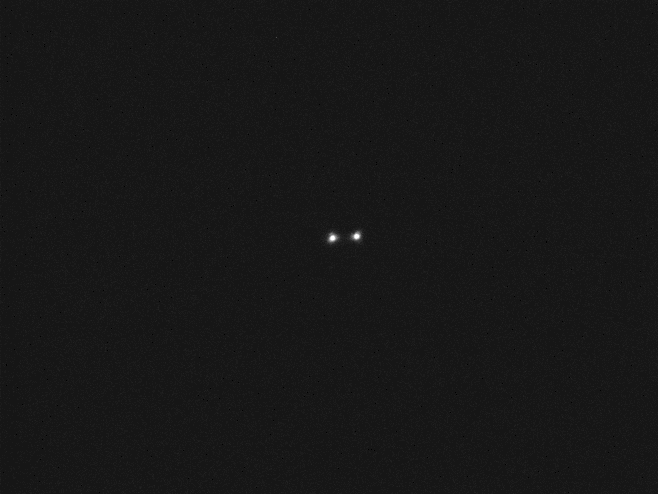|
Seeing, caused by different light refraction in hotter and colder
air, distorts images created by all ground-based telescopes. Because
seeing is caused by atmosphere, it depends on current weather and also
differs from site to site. While light pollution can be measured
relatively easily by taking several exposures and measuring sky
background levels, measuring seeing is more complicated.
While the seeing is often expressed as the angular diameter of the
star image profile in the half of its maximum (FWHM—Full Width Half Maximum), estimating it from the single
star image is quite inaccurate—star image
profile is affected not only by seeing, but also by mount tracking
errors etc.
Much more reliable and accurate is measuring of differential motion
of two (or more) images of single star. Aperture mask with two (or
more) holes must be inserted in front of the telescope. Slight
de-focusing of the telescope causes splitting of the star image to two
parts. Each part of the image is created by light, which passed
through one hole in the aperture mask. Because each light beam passed
through different portion of the atmosphere, it moves slightly due to
seeing. Measuring relative distance of images instead of their
absolute position on the frame eliminates mount tracking errors, wind
gusts etc.

Image of Polaris, split by telescope aperture mask, shows
seeing Astronomers from the Astronomical Institute of Academy of Sciences
of the Czech Republic (http://www.asu.cas.cz/) started searching for the
best place for the new telescope with 2 m
mirror. They built their own DIMM setup from commercial
9.25 inch (235 mm) Schmidt-Cassegrain telescope (STC), G1-0300 CCD
camera and laptop computer running SIMS (Simple Image Manipulation
System) software package.
G1-0300 camera on the Celestron
9.25 inch telescope
(left) and whole DIMM setup on the candidate site (right) The G1 camera takes very short exposures (0.005
sec) of Polaris (Alpha UMi) and stores a series of several hundreds of
images on the computer. SIMS then determines centroids of each Polaris
image, which allows calculation of the current seeing in the
particular time interval. The measurement is then repeated for the
whole night—this allows evaluation of the
seeing on the particular site and its development through the night.
G1 camera takes many tens of thousands of frames per night.
G1-0300 on the back side of the Celestron CPC 925 All images courtesy of Kamil Hornoch, AsU CAS Czech Republic.
|